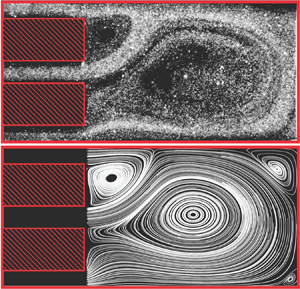Published online by Cambridge University Press: 07 September 2020

Ureteroscopy is a minimally invasive surgical procedure for the removal of kidney stones. A ureteroscope, containing a hollow, cylindrical working channel, is inserted into the patient's kidney. The renal space proximal to the scope tip is irrigated, to clear stone particles and debris, with a saline solution that flows in through the working channel. We consider the fluid dynamics of irrigation fluid within the renal pelvis, resulting from the emerging jet through the working channel and return flow through an access sheath. Representing the renal pelvis as a two-dimensional rectangular cavity, we investigate the effects of flow rate and cavity size on flow structure and subsequent clearance time of debris. Fluid flow is modelled with the steady incompressible Navier–Stokes equations, with an imposed Poiseuille profile at the inlet boundary to model the jet of saline, and zero-stress conditions on the outlets. The resulting flow patterns in the cavity contain multiple vortical structures. We demonstrate the existence of multiple solutions dependent on the Reynolds number of the flow and the aspect ratio of the cavity using complementary numerical simulations and particle image velocimetry experiments. The clearance of an initial debris cloud is simulated via solutions to an advection–diffusion equation and we characterise the effects of the initial position of the debris cloud within the vortical flow and the Péclet number on clearance time. With only weak diffusion, debris that initiates within closed streamlines can become trapped. We discuss a flow manipulation strategy to extract debris from vortices and decrease washout time.